|
|
|
Sort Order |
|
|
|
Items / Page
|
|
|
|
|
|
|
| Srl | Item |
| 1 |
ID:
185029
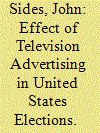

|
|
|
|
|
| Summary/Abstract |
We provide a comprehensive assessment of the influence of television advertising on United States election outcomes from 2000–2018. We expand on previous research by including presidential, Senate, House, gubernatorial, Attorney General, and state Treasurer elections and using both difference-in-differences and border-discontinuity research designs to help identify the causal effect of advertising. We find that televised broadcast campaign advertising matters up and down the ballot, but it has much larger effects in down-ballot elections than in presidential elections. Using survey and voter registration data from multiple election cycles, we also show that the primary mechanism for ad effects is persuasion, not the mobilization of partisans. Our results have implications for the study of campaigns and elections as well as voter decision making and information processing.
|
|
|
|
|
|
|
|
|
|
|
|
|
|
|
|
| 2 |
ID:
134794
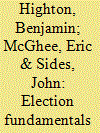

|
|
|
|
|
| Summary/Abstract |
Our congressional forecasting model provides predictions of individual House and Senate races as well as aggregate party seat shares in each chamber. It does so by marrying an underlying structural or “fundamentals”-based model with available polling data—an approach similar to Linzer (2013).
The structural portion of the model is based on contested House and Senate elections from 1980 to 2012, excluding those when an independent or third-party candidate won a significant share of the vote. 1 The dependent variable is the Democratic candidate’s share of the major-party vote. The independent variables are drawn from the extensive literature that has identified significant national and state or district correlates of congressional election outcomes (e.g., Jacobson 2012). These include:
|
|
|
|
|
|
|
|
|
|
|
|
|
|
|
|
| 3 |
ID:
131667
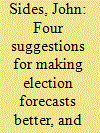

|
|
|
| 4 |
ID:
105378
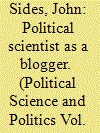

|
|
|
|
|
| Publication |
2011.
|
| Summary/Abstract |
In November 2007, I helped found a blog, The Monkey Cage, with two of my colleagues, David Park and Lee Sigelman. This site joined a nascent political science blogosphere that is now composed of at least 80 blogs (Farrell and Sides 2010). The goals of The Monkey Cage are to publicize political science research and use this research to comment on current events. Although blogging is a promising way for scholars to promote their work to a larger audience, political scientists have been slow to take up this medium. To be sure, blogging is not without its challenges, particularly in terms of the time and energy needed to maintain a site. But blogging can also have its benefits by not only helping political science reach a broader audience, but also aiding individual scholars' research, teaching, and service goals.
|
|
|
|
|
|
|
|
|
|
|
|
|
|
|
|
| 5 |
ID:
096287
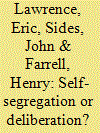

|
|
|
|
|
| Publication |
2010.
|
| Summary/Abstract |
Political scientists and political theorists debate the relationship between participation and deliberation among citizens with different political viewpoints. Blogs provide an important testing ground for their claims. We examine deliberation, polarization, and political participation among blog readers. We find that blog readers gravitate toward blogs that accord with their political beliefs. Few read blogs on both the left and right of the ideological spectrum. Furthermore, those who read left-wing blogs and those who read right-wing blogs are ideologically far apart. Blog readers are more polarized than either non-blog-readers or consumers of various television news programs, and roughly as polarized as US senators. Blog readers also participate more in politics than non-blog readers. Readers of blogs of different ideological dispositions do not participate less than those who read only blogs of one ideological disposition. Instead, readers of both left- and right-wing blogs and readers of exclusively leftwing blogs participate at similar levels, and both participate more than readers of exclusively right-wing blogs. This may reflect social movement-building efforts by left-wing bloggers.
|
|
|
|
|
|
|
|
|
|
|
|
|
|
|
|
|
|
|
|
|